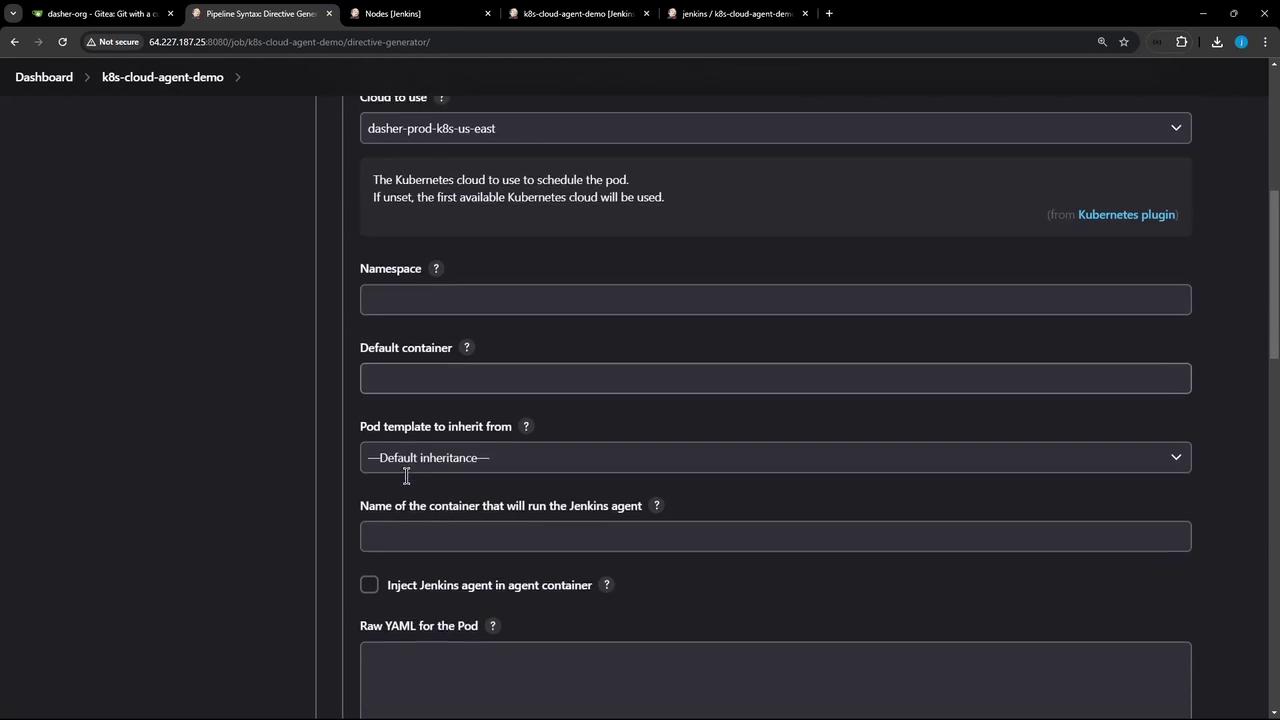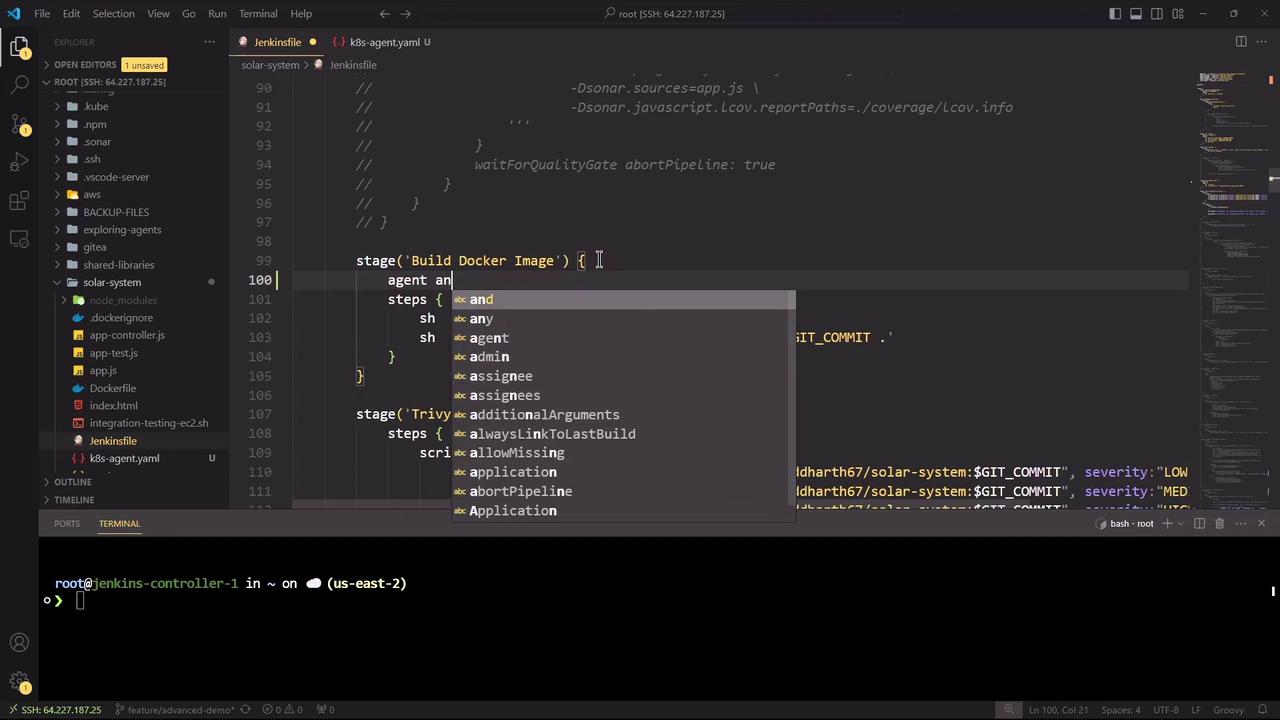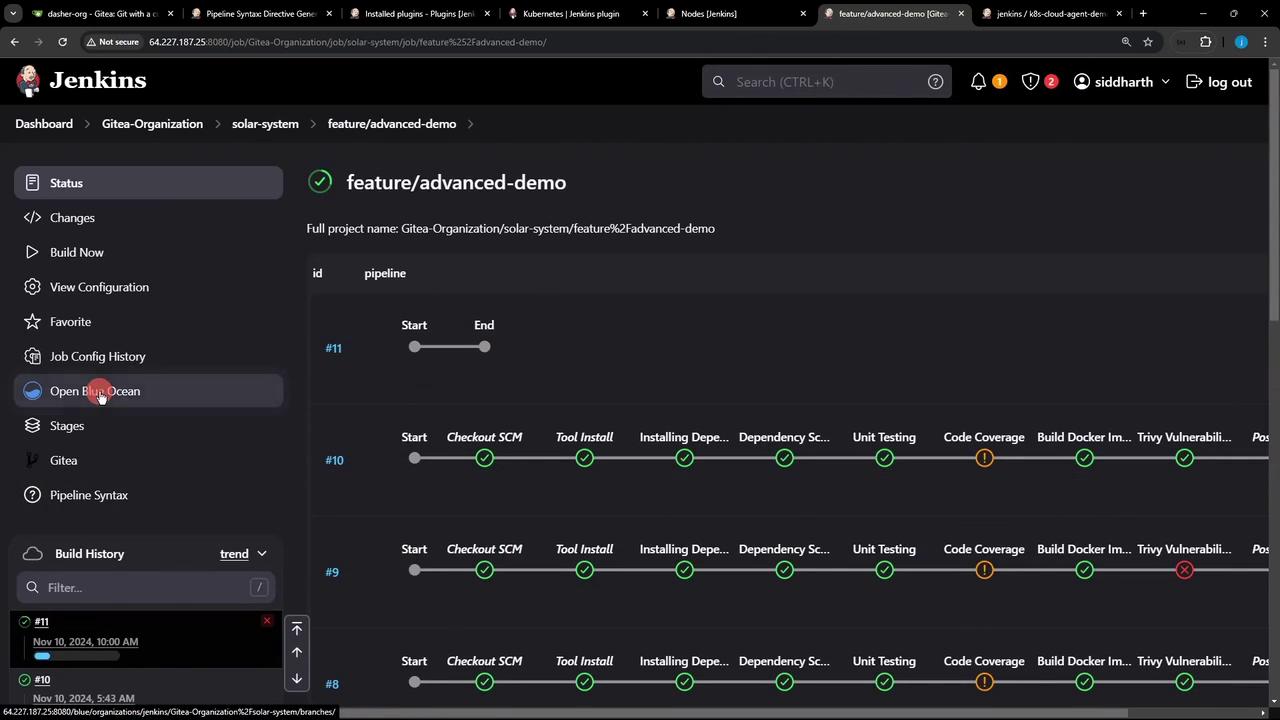Certified Jenkins Engineer
Pipeline Enhancement and Caching
Demo Refactoring Solar System Pipeline
In this guide, we'll transform the existing Solar System Pipeline Jenkinsfile from using agent any to leveraging a Kubernetes agent. By externalizing Pod definitions into a YAML manifest and targeting specific Node.js containers for build stages, we achieve more consistent, scalable CI/CD workflows.
Original Jenkinsfile Overview
The current pipeline uses a generic agent and defines global tools, environment variables, and stages:
pipeline {
agent any
environment {
MONGO_URI = "mongodb+srv://supercluster.d83jj.mongodb.net/superData"
MONGO_DB_CREDS = credentials('mongo-db-credentials')
MONGO_USERNAME = credentials('mongo-db-username')
MONGO_PASSWORD = credentials('mongo-db-password')
SONAR_SCANNER_HOME = tool 'sonarqube-scanner-610'
GITEA_TOKEN = credentials('gitea-api-token')
}
options {
// Shared pipeline options
}
stages {
stage('Installing Dependencies') {
options { timestamps() }
steps {
// npm install, etc.
}
}
// Additional stages...
}
}
| Feature | Description |
|---|---|
| agent any | Runs on any available Jenkins node |
| environment variables | Database URIs, credentials, and SonarQube scanner path |
| stages | Dependency install, tests, Docker build, security scans |
Defining the Kubernetes Pod Manifest
Create a k8s-agent.yaml at your repo root to specify two Node.js containers:
apiVersion: v1
kind: Pod
spec:
containers:
- name: node-18
image: node:18-alpine
command: ["cat"]
tty: true
- name: node-19
image: node:19-alpine
command: ["cat"]
tty: true
This manifest defines the node-18 and node-19 containers that Jenkins will schedule within a single Pod.
Note
Ensure the Kubernetes plugin is installed in Jenkins and your Kubernetes cloud configuration (dasher-prod-k8s-us-east) is active before running the refactored pipeline.
Refactoring Jenkinsfile to Use Kubernetes Agent
Replace the top-level agent any with the kubernetes agent block, referencing the YAML manifest and defaulting to node-18:
pipeline {
agent {
kubernetes {
cloud 'dasher-prod-k8s-us-east'
yamlFile 'k8s-agent.yaml'
defaultContainer 'node-18'
}
}
tools {
// Tool declarations here
}
environment {
MONGO_URI = "mongodb+srv://supercluster.d83jj.mongodb.net/superData"
MONGO_DB_CREDS = credentials('mongo-db-credentials')
MONGO_USERNAME = credentials('mongo-db-username')
MONGO_PASSWORD = credentials('mongo-db-password')
SONAR_SCANNER_HOME = tool 'sonarqube-scanner-610'
GITEA_TOKEN = credentials('gitea-api-token')
}
options {
// Pipeline-level options
}
stages {
// Updated stages below
}
}

Stage-Level Container Configuration
We’ll run Node.js–specific stages in node-18, while Docker build and security scans fall back to agent any. Here’s the updated stage block:
stages {
stage('Installing Dependencies') {
options { timestamps() }
steps {
container('node-18') {
sh 'node -v'
sh 'npm install --no-audit'
}
}
}
stage('Dependency Scanning') {
parallel {
stage('NPM Dependency Audit') {
steps {
container('node-18') {
sh '''
node -v
npm audit --audit-level=critical
echo $?
'''
}
}
}
}
}
stage('Unit Testing') {
options { retry(2) }
steps {
container('node-18') {
sh 'npm test'
}
}
}
stage('Code Coverage') {
steps {
container('node-18') {
catchError(buildResult: 'SUCCESS', message: 'Coverage step failed, will fix later', stageResult: currentBuild.currentResult) {
sh 'node -v'
sh 'npm run coverage'
}
}
}
}
stage('Build Docker Image') {
agent any
steps {
sh 'printenv'
sh 'docker build -t siddharth67/solar-system:$GIT_COMMIT .'
}
}
stage('Trivy Vulnerability Scanner') {
agent any
steps {
script {
trivyScanScript.vulnerability(imageName: "siddharth67/solar-system:$GIT_COMMIT", severity: "LOW")
trivyScanScript.vulnerability(imageName: "siddharth67/solar-system:$GIT_COMMIT", severity: "MEDIUM")
trivyScanScript.vulnerability(imageName: "siddharth67/solar-system:$GIT_COMMIT", severity: "HIGH")
}
}
}
}
| Stage | Container | Agent |
|---|---|---|
| Installing Dependencies | node-18 | kubernetes |
| Dependency Scanning | node-18 | kubernetes |
| Unit Testing | node-18 | kubernetes |
| Code Coverage | node-18 | kubernetes |
| Build Docker Image | default host | any |
| Trivy Vulnerability | default host | any |

Running and Monitoring the Refactored Pipeline
Commit your changes and push to trigger the pipeline. You can monitor status and logs in Blue Ocean:

The console output confirms that the Pod definition was fetched and containers spun up:

15:31:10 + node -v
15:31:10 v18.20.4
15:31:11 + npm install --no-audit
15:31:16 added 358 packages in 4s
...
15:31:30 + npm test
...
15:32:02 + npm run coverage
...
Note
All Node.js stages share an emptyDir volume by default, so dependencies installed in one stage persist for subsequent stages within the same Pod.
Links and References
- Jenkins Kubernetes Plugin
- Blue Ocean Documentation
- Kubernetes Pod Spec
- Trivy Security Scanner
- Jenkins Pipeline Syntax
Watch Video
Watch video content